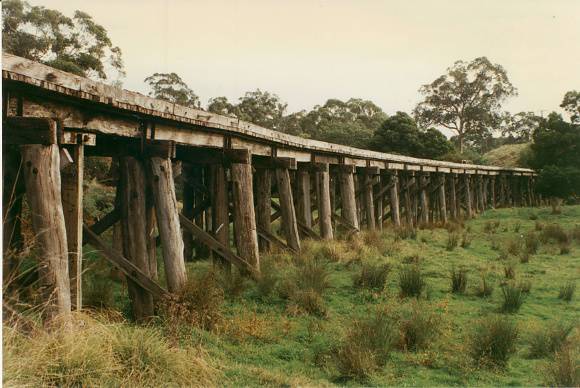| Back to search results » | Back to search page » |
|
Koonwarra Rail Bridge,Tarwin River West Branch NO 1 Bridge, Tarwin River West Branch No 2 Bridge
LocationBeside South Gippsland Highway,, KOONWARRA VIC 3954 - Property No B6953
File NumberB6953LevelState |
|
Statement of Significance
This group of three surviving impressive timber-beam rail bridges in very close proximity to one another, built in 1892 where the Great Southern Railway passed eastwards onto the Tarwin River flats near Koonwarra in South Gippsland, is of historical and aesthetic significance at State level. All three structures are located along half a kilometre of railway line, which makes for an unusual timber-bridge series that is very accessible from the nearby South Gippsland Highway. They are among the most spectacular surviving engineering relics from the historic Great Southern Railway, which did so much to convert great stretches of South Gippsland from trackless forest wilderness into fertile farm lands.
The first bridge is the shortest of the three, and was built to a smaller fifteen-feet transverse-timber deck design. The bigger pair, with their sweeping curved timber decks over the Tarwin River, were constructed to the maximum Victorian Railways twenty-feet timber-beam span design. This twenty feet (6.1 metre) span length was the longest used for Victorian Railways bridges built after 1880, and very few big timber river bridges, having all their spans built to this length, now survive.
Being among the most expensive engineering works on the loss-making stretch of railway between Leongatha and Alberton, the Tarwin River railway bridges contributed significantly to the late nineteenth century reputation of the Great Southern Line as the prime example of 'crazy' boom-era railway construction, and the supreme symbol of Octopus Acts' 'extravagance'. Great Southern railway 'waste and extravagance' gained notoriety particularly through David Syme's Age newspaper, which became embroiled in a legal vendetta with the Victorian Railway Commissioners and used this railway to ridicule boom-era railway-construction policy.
Despite that early notoriety, the Tarwin Valley railway bridges served South East Gippsland very effectively for a century. Without the existence of these bridges, the agricultural development of fertile forest lands in South Gippsland would have been greatly retarded. These bridges made a special contribution to the ever-expanding Victorian Railways system in the early 20th century, because the line of which they were an essential component carried huge tonnages of superior rail-sleepers and timber-bridge materials from the extensive yellow stringy bark and bluegum forests of South Gippsland, for use across the State. The construction of this unusual series of timber bridges, and the line which they served, also meant the end of a long era of dependence on coastal shipping for the historic Port Albert-Alberton region of South Gippsland.
These three timber bridges built in close proximity are also of considerable aesthetic merit. Set amidst picturesque rolling Gippsland grasslands that are dotted with big eucalypts, the long sweeping deck curve of the river bridge closest to the highway makes spectacular viewing when viewed from the roadside high above. This impressive series of timber-beam rail bridges between Koonwarra and Tarwin have only been out of use since 1994, which means that they are in better condition than most others of their kind scattered around Victoria. They are also unusually accessible to the public, from the adjacent South Gippsland Highway.
Classified: 10/11/1998
Group
Transport - Rail
Category
Railway Bridge/ Viaduct




